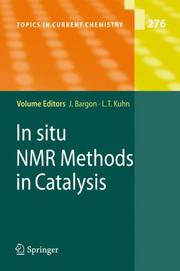| Listing 1 - 1 of 1 |
Sort by
|

ISSN: 03401022 ISBN: 9783540714262 9783540714279 354071426X Year: 2007 Volume: 276 Publisher: Berlin, Heidelberg Springer-Verlag Berlin Heidelberg
Abstract | Keywords | Export | Availability | Bookmark
 Loading...
Loading...Choose an application
- Reference Manager
- EndNote
- RefWorks (Direct export to RefWorks)
Achemist,facedwiththeproblemofdeterminingthemechanismofachemical reaction, tries to identify a set of reactions that will account for the observed behavior:Ideally,asmallsetofknownreactionsshoulddescribeingreatdetail exactly what takes place at each stage of a chemical transformation. The fact that many reactions proceed in a stepwise fashion can most convincingly be demonstrated if intermediate species can be isolated and shown to proceed to the same products under otherwise identical reaction conditions. An - termediate is the reaction product of each of these steps, except for the last onethatformsthe?nalproduct. Someintermediatesarestablecompoundsin theirownright;someothers,however,aresoreactivethattheirisolationisnot possible. Occasionally, evidence for the existence of short-lived intermediates may be obtained, in particular by spectroscopic observation. The latter may - low a direct observation or an indirect inference from unusual phenomena occurring in the reaction products during in situ investigations of their c- responding chemical reactions. In NMR spectroscopy, for example, transient emissionandenhanced absorptionlinesmaybeobserved, andoneisinclined to believe that there is a universal and unambiguous reason for their appe- ance. Thisisnotnecessarilythecase,however,sincethisseeminglyidentical phenomenon may have a strikingly different origin: During free radical re- tions,aphenomenoncalledchemicallyinduced dynamicnuclear polarization (CIDNP) may give rise to virtually the same effect as occasionally observed duringhomogeneous(andpossiblyevenheterogeneous)hydrogenations:The latter phenomenon, called parahydrogen-induced polarization (PHIP), has a completely different physical basis. It was ?rst noticed twenty years later than CIDNP and occurs if there is an imbalance of the two spin isomers of symmetric molecules such as dihydrogen when hydrogenating unsaturated compoundsusingappropriatecatalysts. Thesetwoeffects,ifnotdifferentiated properly, can cause misinterpretations of reaction mechanisms, as occurred initially when their different origins had not yet been understood approp- ately.
| Listing 1 - 1 of 1 |
Sort by
|

 Search
Search Feedback
Feedback About UniCat
About UniCat  Help
Help News
News